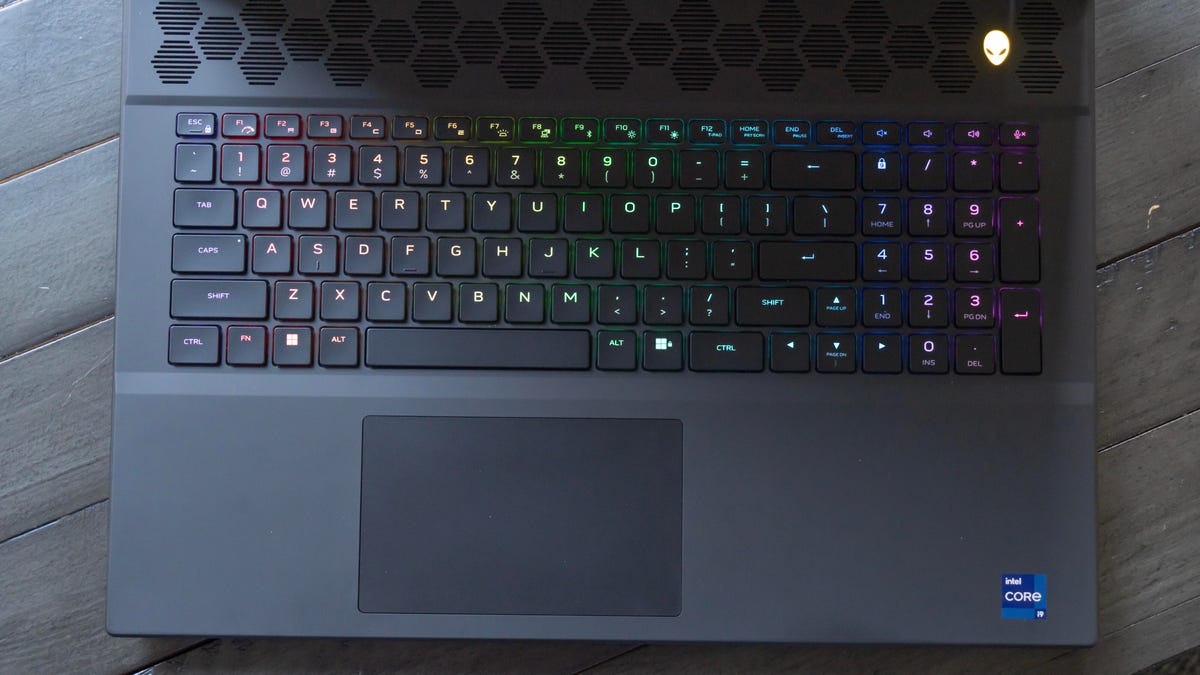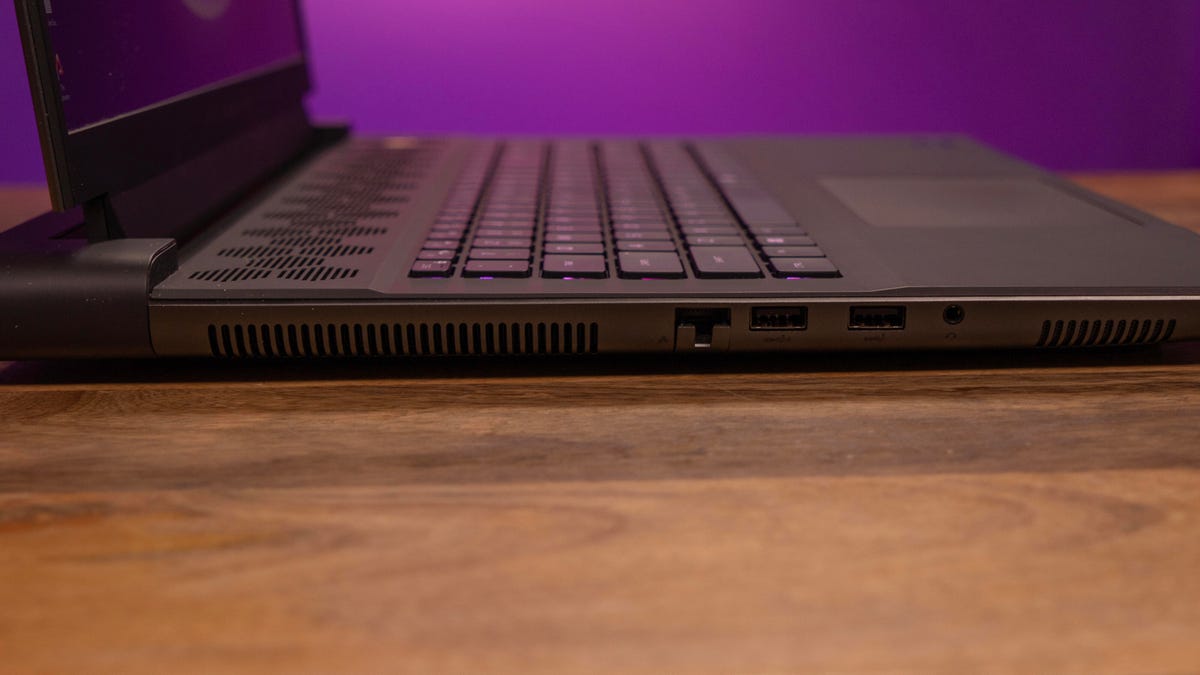Tech News
Alienware M18 R2 Gaming Laptop Review: When Speed Is of The Essence - CNET
A simple refresh of the debut model, the Alienware m18 R1, the m18 R2's main differences from its predecessor are the 14th-gen Intel HX CPUs it now uses and updated networking. It's still a powerful gaming-laptop-slash-desktop-replacement, but I can't help be a little disappointed by the display choices. If you plan to use a standalone monitor most of the time, it's not that big a deal, though.
The line starts at roughly $1,900, which is on the low side compared to competitors like the Asus ROG Strix G18, Acer Predator Helios Neo 18, Razer Blade 18 and more, but that's primarily because their base configurations are in some way higher-powered than the m18. The Alienware starts at a Core i7-14650HX and GeForce RTX 4060, while the rest start with a Core i9-14900HX and/or RTX 4070, along with the same display as the m18 or better.
Alienware m18 R2
| Display | 18-inch, 2,560x1,600-pixel, 165Hz, IPS, 300 nits |
|---|---|
| PC CPU | 2.4GHz Intel Core i9-14900HX |
| PC Memory | 32GB DDR5-5600 |
| Graphics | 16GB GDDR6 Nvidia GeForce RTX 4090 at 175W |
| Storage | 2TB SSD, SD card slot |
| Ports | 3x USB-C (2x Thunderbolt 4 with DP 1.4), 2x USB-A 3.2, 1x HDMI 2.1, 1x mini DisplayPort, 1x combo audio |
| Networking | Dell Killer E5000 Ethernet, Killer Wi-Fi 7 BE1750x, Bluetooth 5.4 |
| Operating system | Windows 11 Home 23H2 |
| Weight | 9.3 pounds (4.3 kg) |
You can configure the m18 R2 with up to the i9-14900HX, RTX 4090, 64GB RAM, 8TB RAID0 solid-state drive and a 480Hz 1200p display, plus some other customizations, which will run you almost $4,600. That leaves a lot of room in between. We tested a relatively high-end configuration with less memory, storage and a slower but higher-resolution display than the top end, which runs about $3,300 at the moment.
It's hard to make a recommendation for a specific configuration because there are a lot of different reasons for opting for an 18-inch laptop. For instance, you may just want the bigger screen and not care about speed, in which case the i7/RTX 4060 model might be a good choice (since there aren't a lot of 18-inch mainstream laptops). It's also conceivable that Alienware will eventually offer a higher end (i.e., i9-14980HX class) processor, so if you need something beyond this you might want to wait.

An illuminated ring surrounds the rear ports: two USB-C, mini DisplayPort, HDMI, USB-A and SD card slot.
Lori Grunin/CNETThe design hasn't changed. It still has the forward hinge, RGB lighting around the rear, ports scattered around three sides, curved wedge profile and anodized aluminum build, plus a full set of connections. Alienware has slimmed down the power brick to the smaller curved design of the mainstream laptop adapters, but the laptop itself has gained some weight -- it now hits a max of 9.3 pounds (4.3 kg), up from 8.9 pounds -- so it can weigh well over 10 pounds on your back.
Our eval unit included the Cherry MX ULP tactile-switch mechanical keyboard. I find they're an acquired taste, with more travel than most laptop keyboards and requiring a bit too much actuation force. But it really depends on what you're used to.

The m18 has a full keyboard with per-key RGB lighting.
Lori Grunin/CNETThe power connector is on the back, which makes sense given how much space on the sides is dedicated to ventilation. The side vents didn't get as hot as with the smaller m16 R2, but as you'd expect the fans can get pretty loud, especially in Performance and Overdrive modes. The brick does get uncomfortably warm, which may be a consideration if you don't have any place to put it, given the overly short cable between the outlet and the brick. It's a standard connection to the brick, though, so you can replace it with a longer power cable if necessary.
Performance and display
The screen is a run-of-the-mill 300-nit IPS panel with a maximum refresh rate of 165Hz, albeit one with a relatively broad color gamut measuring 98% of P3. The 2,560x1,600-pixel resolution is OK for gaming but I'd prefer it to be higher for work. The alternative 1,920x1,200 240Hz panel is too low-res, unless you only care about max frame-rate gaming in 1080p, or plan to use an external monitor for work or games that are more about the looks than the speed.
SDR Color measurements
| White point | 6400K |
|---|---|
| Gamma | 2.0 |
| Full screen brightness (center, nits) | 293 |
| Accuracy (DE2K average/max) | 4.16/7.67 |
| Contrast | 1193:1 |
I saw some edgelight leakage in the upper left and lower right corners of the screen, and there was some noticeable nonuniformity -- 293 nits peak in the center instead of 300-plus nits, and as low as 246 nits in the lower right. It had gamma 2.0 rather than 2.2 and a higher level of color inaccuracy than usual. Except for the edgelight issue, which can be an outlier, the screen performs... fine.
The RTX 4090 in the system is certainly up to fast 1440p and solid 4K, but even some games didn't saturate the GPU bus in 1440p, so the lack of a higher-resolution panel option or HDR support is sad. But in order to achieve high brightness, the only panel choices in this size use mini-LED backlights, which can be a lot more expensive or hard to implement well.

The laptop's profile looks thinner than it feels.
Lori Grunin/CNETOverall performance is about where you'd expect for the components, and given that the R1 we tested had a more powerful class i9-13980HX CPU, the nearly identical processing performance is a good showing; ditto for the RTX 4090. But if you're planning to use this as a desktop replacement, don't assume you're getting "RTX 4090" performance. The mobile RTX 4090 performed only between the RTX 4070 Super and RTX 4070 Ti Super desktop cards across the board, in gaming, pro graphics and AI. I saw very little return to Performance and Overdrive modes across several tests.
Since this is the HX-class CPU, we didn't expect terrific battery life, and it came in at just under five hours for our light-load video playback test. But it's pretty much in 18-inch gaming laptop territory.
If you're going to be toting it around a lot, you may want to consider paying more for a lighter-weight design, like that of the 6.8-pound Razer Blade 18. And if you want to use it for more than just gaming I'd recommend one with a better screen. (Caveat: I haven't tested the latest competitors yet.) But if you need a really powerful laptop for light or no travel, this one can drive multiple monitors at high resolutions and fill your performance needs for all sorts of work and play.
Geekbench 6 (multicore)
Asus ROG Zephyrus G14 (2024) 13,038Samsung Galaxy Book 4 Ultra 13,137ASUS ROG Strix 17 (2023) 15,742Acer Predator Helios 18 (2023) 17,750Alienware m18 R2 17,862Alienware m18 R1 18,196
Note: Longer bars indicate better performanceCinebench R23 CPU (multicore)
Razer Blade 18 (2023) 16,331Alienware m18 R2 28,463Acer Predator Helios 18 (2023) 29,055Alienware m18 R1 31,938ASUS ROG Strix 17 (2023) 32,544
Note: Longer bars indicate better performanceStreaming video playback battery drain test
ASUS ROG Strix 17 (2023) 189Alienware m18 R1 249Acer Predator Helios 18 (2023) 256Alienware m18 R2 297Razer Blade 18 (2023) 307
Note: Longer bars indicate better performance (minutes)The Rift Breaker CPU gaming test (1080p)
Acer Predator Helios 18 (2023) 138.94ASUS ROG Strix 17 (2023) 148.93Alienware m18 R2 172.51Alienware m18 R1 182.03
Note: Longer bars indicate better performance (frames per second)3DMark Time Spy
Acer Predator Helios 18 (2023) 15,319Razer Blade 18 (2023) 15,504ASUS ROG Strix 17 (2023) 18,516Alienware m18 R1 20,550Alienware m18 R2 21,161RTX 4070 Ti Super 22,887
Note: Longer bars indicate better performance3DMark Fire Strike Ultra
Acer Predator Helios 18 (2023) 9,370ASUS ROG Strix 17 (2023) 12,501Alienware m18 R2 13,628Alienware m18 R1 13,842RTX 4070 Ti Super 14,701
Note: Longer bars indicate better performanceGuardians of the Galaxy (High at 1,920x1,080)
Razer Blade 18 (2023) 141Alienware m18 R2 (max quality with ray tracing) 156ASUS ROG Strix 17 (2023) 165Alienware m18 R2 (1600p) 180Acer Predator Helios 18 (2023) 186Alienware m18 R2 196Alienware m18 R1 202
Note: Longer bars indicate better performance (frames per second)Procyon Stable Diffusion XL
Alienware m18 R2 2,276RTX 4070 Ti Super 2,660
Note: Longer bars indicate better performanceSpecViewPerf 2020 3.1 Energy (1080p)
RTX 4070 Super 69.00Alienware m18 R2 73.14RTX 4070 Ti Super 74.21
Note: Longer bars indicate better performance (frames per second)Configurations
| Alienware m18 R1 | Microsoft Windows 11 Pro 22H2; 2.2GHz Intel Core i9-13980HX; 32GB DDR5-5800 RAM; 16GB Nvidia GeForce RTX 4090 GPU; 1TB SSD |
|---|---|
| Alienware m18 R2 | Microsoft Windows 11 Home 23H2; 2.2GHz Intel Core 19-14900HX; 32GB DDR5-5600 RAM; 16GB GDDR6 Nvidia GeForce RTX 4090 GPU @ 175w; 2TB SSD |
| Asus ROG Strix 17 (2023) | Microsoft Windows 11 Pro 22H2; 2.5GHz AMD Ryzen 9 7945HX; 32GB DDR5-4800 RAM; 16GB Nvidia GeForce RTX 4090 GPU; 1TB SSD |
| Asus ROG Zephyrus G14 (2024) | Microsoft Windows 11 Home 22H2; 3.6GHz AMD Ryzen 9845HS; 32GB LPDDR5-6400 RAM; 8GB Nvidia GeForce RTX 4070 GPU; 1TB SSD |
| Custom PC (RTX 4070 Super, RTX 4070 Ti Super) | Microsoft Windows 11 Pro 22H2/23H2; 3.2GHz Intel Core i9-12900K; 32GB DDR5-4800; 2x Corsair MP600 Pro SSD; Corsair HX1200 80 Plus Platinum PSU, MSI MPG Z690 Force Wi-Fi motherboard, Corsair 4000D Airflow midtower case |
| Razer Blade 18 (2023) | Microsoft Windows 11 Home 22H2; 2.2GHz Intel Core i9-13950HX; 32GB DDR5-5600 RAM; 12GB Nvidia GeForce RTX 4080 GPU; 1TB SSD |
| Samsung Galaxy Book 4 Ultra | Microsoft Windows 11 Home 23H2; 2.5GHz Intel Core Ultra 9 185H; 32GB LPDDR5-7466 RAM; 8GB Nvidia GeForce RTX 4070 GPU; 1TB SSD |
How we test computers
The review process for laptops, desktops, tablets and other computerlike devices consists of two parts: performance testing under controlled conditions in the CNET Labs and extensive hands-on use by our expert reviewers. This includes evaluating a device's aesthetics, ergonomics and features. A final review verdict is a combination of both objective and subjective judgments.
The list of benchmarking software we use changes over time as the devices we test evolve. The most important core tests we're currently running on every compatible computer include Primate Labs Geekbench 6, Cinebench 2024, PCMark 10 and 3DMark Fire Strike Ultra.
A more detailed description of each benchmark and how we use it can be found on our how we test computers page.
When you subscribe to the blog, we will send you an e-mail when there are new updates on the site so you wouldn't miss them.



Comments